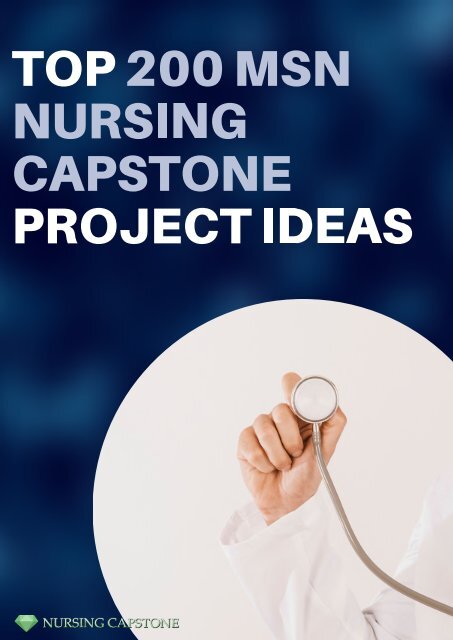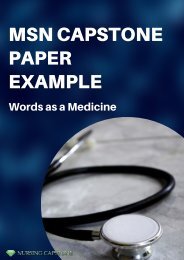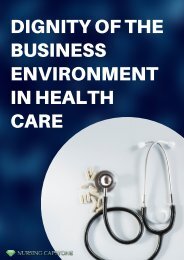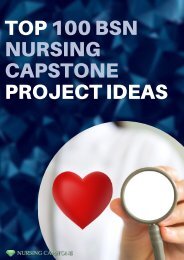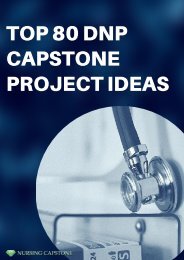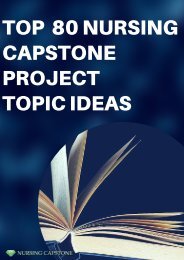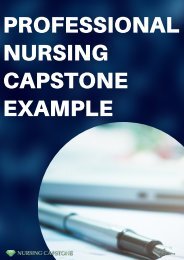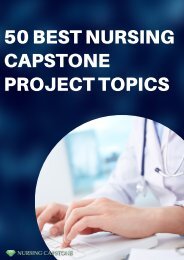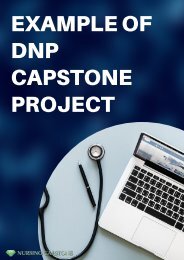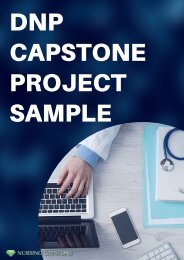Professional MSN Nursing Capstone Project Ideas
Howdy! Here is where you can find some terrific professional msn nursing capstone project ideas. If you need more go to https://www.nursingcapstone.net/msn-nursing-capstone-project-writing-expert-guide-to-follow/
Howdy! Here is where you can find some terrific professional msn nursing capstone project ideas. If you need more go to https://www.nursingcapstone.net/msn-nursing-capstone-project-writing-expert-guide-to-follow/
Create successful ePaper yourself
Turn your PDF publications into a flip-book with our unique Google optimized e-Paper software.
TOP 200 <strong>MSN</strong><br />
NURSING<br />
CAPSTONE<br />
PROJECT IDEAS
Public health advocacy for pregnant minorities<br />
1<br />
Clinical techniques in making anesthesia more safe<br />
2<br />
Development of the nursing assessment tool<br />
3<br />
Improving education around HPV and its vaccine<br />
4<br />
Relation of STDs among women in relation to behavioral health<br />
5<br />
issues<br />
Effective wound care for patients<br />
6<br />
Patients with an altered body and their psychological assistance<br />
7<br />
Specific immunization regimen with systematic instruction<br />
8<br />
Preventing infections in healthcare establishments<br />
9<br />
Handling diabetes in young children through testing qualitative<br />
10<br />
methods<br />
Psychological assessments, specifically with depression<br />
11<br />
Addressing cross-cultural and generational diversity in nursing<br />
12<br />
training<br />
Ambulatory care settings with strategies for quick response<br />
13<br />
Promotion and education of breastfeeding practices<br />
14<br />
Research in home transfers<br />
15<br />
Recognizing risk factors tied to bottle and breastfeeding for<br />
16<br />
infants after intensive care<br />
premature<br />
Difference between modern and old healthcare<br />
17<br />
Education for chronic obstructive pulmonary disease<br />
18<br />
Online learning VS classroom of nursing<br />
19<br />
Cardiac skills for teens<br />
20<br />
Concept-based learning strategies to create nurse leaders<br />
21<br />
Study of nurses with multicultural backgrounds in clinical settings<br />
22<br />
Concept advancement of nursing care management<br />
23<br />
Use of tents for birthing babies<br />
24<br />
Using evidence-based childbirth guidelines for volunteer<br />
25<br />
healthcare
Evaluating the effectiveness of nursing training<br />
26<br />
Mental health referral practices in family medicine clinics<br />
27<br />
Giving transition of shock training to patients<br />
28<br />
Integration of medical strategies to promote and influence<br />
29<br />
breastfeeding<br />
Development of Vitamin D deficiency screening for patients with<br />
30<br />
of osteoporosis<br />
history<br />
Relationship between longer hospital shifts of nurses and quality<br />
31<br />
patients care<br />
of<br />
Prevention and management of Type 3 Diabetes<br />
32<br />
Lyme disease prevention among children<br />
33<br />
Increasing access to care for pregnant women<br />
34<br />
Improving pain management among nurses<br />
35<br />
Education and asthma care in nursing homes<br />
36<br />
Education program of asthma among students<br />
37<br />
Non-pharmaceutical management of psychological systems<br />
38<br />
Inventional program for treatment of obesity<br />
39<br />
Discharge planning for nursing students and its improvements<br />
40<br />
Study of dementia patients and preventing dysfunctional<br />
41<br />
behaviors<br />
Cardiac skills and clinical utility<br />
42<br />
Developing a discrepancy audit tool for medical reconciliation<br />
43<br />
discrepancy<br />
Checklist for adolescents transitioning out of intensive inpatient<br />
44<br />
care<br />
Addiction of stimulants in adolescents<br />
45<br />
Palliative care patients in emergency department<br />
46<br />
Emergency department utilization among palliative care patients<br />
47<br />
Development of tools for survival in novice neurosurgery<br />
48<br />
Developing a survival tool for novice neurosurgery practitioners<br />
49<br />
50 Children with disorders such as bipolar disorder or ADHD
Bipolar disorder and ADHD children<br />
51<br />
Management in nursing involving women’s health issues<br />
52<br />
<strong>Nursing</strong> management towards women’s health issues<br />
53<br />
Development of personalized approaches for sleep disorder in<br />
54<br />
patients<br />
aging<br />
Personalized approaches to sleep disorder management during<br />
55<br />
aging<br />
Interactions in healthcare<br />
56<br />
Clinical and health outcomes in managed care<br />
57<br />
Dementia behavior in older patients<br />
58<br />
<strong>Nursing</strong> methods in the care of an older patient<br />
59<br />
Medicine for environmental and occupational conditions<br />
60<br />
Environmental and occupational medicine<br />
61<br />
Differences between treatment and assessment<br />
62<br />
Sleep apnea screening in patients and connections to heart<br />
63<br />
failure<br />
Relationship between nursing certification and sense of<br />
64<br />
competition<br />
Review of visitation models within the context of patient- and<br />
65<br />
care<br />
family-centered<br />
Study of sexually transmitted diseases<br />
66<br />
Strategies planning approach for patient-centered medical<br />
67<br />
facilities<br />
Use of probiotics in prevention of diarrhea<br />
68<br />
Promoting infant health through breastfeeding support<br />
69<br />
Prevention of rehabilitation readmission of stroke patients<br />
70<br />
Improving medical knowledge about HPV and vaccines<br />
71<br />
Medication management intervention across care changes<br />
72<br />
Disease outbreaks and protective measures for healthcare<br />
73<br />
Role and performance of men in nursing occupation<br />
74<br />
75 Healthcare facilities and instructional programs
Effective critical care response in handling medical emergencies<br />
76<br />
Attitudes and believes about diabetic foot programs<br />
77<br />
Quality of life in patients with prostate cancer<br />
78<br />
Pain assessment tools for adult patients<br />
79<br />
Literature review of cardiovascular disease and stress<br />
80<br />
Impact of nurse-to-patient ratios on patient care outcomes<br />
81<br />
Clinical utility of cardiac skills checklist for teens<br />
82<br />
Development of a medication reconciliation discrepancy audit<br />
83<br />
tool<br />
Transition checklist for adolescents with sickle cell disease<br />
84<br />
Emergency department utilization among palliative care patients<br />
85<br />
The role of nurses in clinics and hospitals for exceptional patient<br />
86<br />
care<br />
How nurses manage providing ample care to each patient?<br />
87<br />
The ways of managing extreme health changes in patients<br />
88<br />
Nurses and doctors: Who are more responsible for the ideal<br />
89<br />
care?<br />
patient<br />
Do the nurses have more responsibilities/job duties than other<br />
90<br />
staff?<br />
medical<br />
<strong>Nursing</strong> programs in medical institutions and universities<br />
91<br />
How nursing career is perfect for the females?<br />
92<br />
The role of nursing profession nowadays<br />
93<br />
Why do nursing is the most honorable profession?<br />
94<br />
Difference between type II and type III diabetes<br />
95<br />
How to differentiate malaria and diarrhea?<br />
96<br />
The average pay scale of nurses in the present time<br />
97<br />
Job duties of nurses in hospitals<br />
98<br />
The cancer patients and their care by nurses<br />
99<br />
100 Impact of good nursing training on patient care
Organization approach on end-of-life-care<br />
101<br />
Protocol development for Vitamin D deficiency screening<br />
102<br />
Nurse care managers usage and diabetic care<br />
105<br />
Handling medical emergencies review<br />
106<br />
Instructional wellness and program initiative for healthcare<br />
107<br />
in ensuring satisfaction<br />
facilities<br />
Public’s perception of performance and role of women in<br />
108<br />
occupations<br />
nursing<br />
Healthcare providers protective measures<br />
109<br />
<strong>Nursing</strong> assessment: dealing with critical care and emergencies<br />
110<br />
patients<br />
<strong>Nursing</strong> assessment tool development in primary care<br />
111<br />
Proper emotional and psychological assistance research<br />
112<br />
Helping and improving mothers to abide with immunization<br />
113<br />
regimen<br />
Testing qualitative methods in preventing and handling<br />
114<br />
and obesity among youth<br />
diabetes<br />
Addressing generational gap in nursing training<br />
115<br />
Strategies for competent and quick response in ambulatory care<br />
116<br />
setting<br />
Private network usage in modern healthcare<br />
117<br />
Education and awareness of obstructive pulmonary disease<br />
118<br />
Online vs classroom learning: report of student effectiveness,<br />
119<br />
and skill development<br />
achievement<br />
Concept-based and evidence based learning strategies in<br />
120<br />
nurse leaders<br />
creating<br />
<strong>Nursing</strong> risk management concept<br />
121<br />
Evaluation on the effectiveness of nursing training<br />
122<br />
Providing transition shock training to all patients dealing with<br />
123<br />
abuse<br />
substance<br />
Assessment of multi-clinic and multi-provider healthcare system’<br />
103<br />
Discussion on acquisition and retention of motivational skills<br />
104
Medical strategies integration in promoting and influencing<br />
124<br />
breastfeeding<br />
Relationship study between hospital shifts and patient care<br />
125<br />
quality<br />
Review on handing medical emergencies<br />
126<br />
Wellness instructions and initiative program for facilities in<br />
127<br />
service satisfaction<br />
ensuring<br />
In-depth look on protective measures on men performance in<br />
128<br />
occupation<br />
nursing<br />
Protective measures during outbreaks<br />
129<br />
Knowledge of health workers about emergencies and critical<br />
130<br />
care<br />
HIV nursing assessment tool<br />
131<br />
Proper emotional and psychological research for patients having<br />
132<br />
disability<br />
Testing qualitative methods review in preventing obesity and<br />
133<br />
diabetes<br />
Strategies for quick response in care setting<br />
134<br />
Concept advancement about nursing care management<br />
135<br />
Complex care issues evaluation in geriatric care management<br />
136<br />
Medical strategies in influencing hospitals about breastfeeding<br />
137<br />
Leading nursing with huge backgrounds in hospital<br />
138<br />
environment<br />
<strong>Nursing</strong> role in treating acute ischemic stroke patient<br />
139<br />
<strong>Nursing</strong> role examination in treating drug dependencies<br />
140<br />
Caring patients having chronic pain<br />
141<br />
Examination about nursing intervention in infectious disease<br />
142<br />
control<br />
<strong>Nursing</strong> measures examination in controlling high blood<br />
143<br />
pressure<br />
<strong>Nursing</strong> practices examination for patients having multiple<br />
144<br />
sclerosis
Exploring the relationship between depression and sleep quality<br />
145<br />
Braden scare usage for ulcer risk<br />
146<br />
Link between medication consequences and its risk<br />
147<br />
Music therapy: pain relief for patients<br />
148<br />
Factors affecting palliative care patients<br />
149<br />
<strong>Nursing</strong> care effects in treatment<br />
150<br />
Reliability discussion of COPE Index<br />
151<br />
Work-related musculoskeletal disorder effects in nurses<br />
152<br />
<strong>Nursing</strong> date discussion in COPD patients<br />
153<br />
Oral hygiene effects on ventilator-associated pneumonia<br />
154<br />
Nurse-led patients effects on quality of life for heart disease<br />
155<br />
patients<br />
Typical care protocols effects on venous catheter infections<br />
156<br />
prevention<br />
Decision making process on intensive care patients<br />
157<br />
Current practices about end-of-life-care<br />
158<br />
End stage on renal disease<br />
159<br />
Health care providers examination in educating patients with<br />
160<br />
2 diabetes<br />
type<br />
Honey products that used in wound care<br />
161<br />
Effects of sports and exercise medicine<br />
162<br />
Bottle feeding vs. breastfeeding<br />
163<br />
Sub-cu lovenox vs. sub-cu heparin<br />
164<br />
Exercise and its effects on depression symptoms<br />
165<br />
Bed alarms in reducing patient falls<br />
166<br />
Effect of air mattresses on skin<br />
167<br />
Health diversity and geriatrics<br />
168<br />
Psychiatric nursing and mental health<br />
169<br />
170 Women’s health nursing and OB Gyn
Neonatal and paediatrics care nursing<br />
171<br />
Adolescent medicine and its benefits<br />
172<br />
Retinal and AMD disease<br />
173<br />
EP and arrhythmia<br />
174<br />
All about bariatric surgery<br />
175<br />
Mineral and bone disorders<br />
176<br />
Refractive and cataract surgery<br />
177<br />
Adolescent and child psychiatry<br />
178<br />
Risk reduction on cardiovascular patients<br />
179<br />
External and cornea disease<br />
180<br />
Complications on diabetic muscovascular<br />
181<br />
Billiary and gallbladder disease<br />
182<br />
Insulin therapy: what it is all about<br />
183<br />
Management on medical practice<br />
184<br />
Legal issues and medical malpractice<br />
185<br />
Help of doctors on weight and obesity management<br />
186<br />
Efficient and effective orientation programs<br />
187<br />
Critical care nursing spirituality<br />
188<br />
Advanced directives<br />
189<br />
Supporting and preparing staff as perceptions for students<br />
190<br />
Critical pathways, care plans and patient care protocols for<br />
191<br />
care<br />
critical<br />
Patient staffing approach<br />
192<br />
Advanced practice nurse collaboration with clinical nurses,<br />
193<br />
managers, staff nurses and specialists<br />
nurse<br />
<strong>Nursing</strong> care children and preventive paediatrics<br />
194<br />
Preventive and promotive lifestyle diseases and health care<br />
195<br />
Mental health problems and needs of people across lifespan<br />
196<br />
197 Women’s and reproductive health care
Genomics and genetics<br />
198<br />
<strong>Nursing</strong> home management impact and practices on patient and<br />
199<br />
issues<br />
staff<br />
Re-emerging and emerging infectious disease<br />
200<br />
CHECK OUT THE BEST TIPS FOR WRITING<br />
AN EXCELLENT <strong>MSN</strong> CAPSTONE IN<br />
NURSING AND ASK US FOR MORE HELP!


